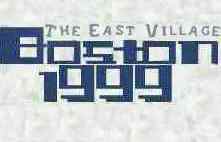
Daniel Bouchard
New England pasture prepares for research seeding facility Outside my workplace Building 20 is coming down. Humongous yellow backhoes dance on tank treads shaking the street, scraping concrete floor from earth. This is a tough field for spring plowing. Massive steel teeth comb and scoop rubble into mounting piles. Mangled stringy rebar spring up in a frenzy, freed from embedment of cement beds. This little lot of MIT resembles, or may resemble, remnants of Belgrade. A little army of Guerette Corporation employs machinery manufactured by Komatsu. This is the celebrated lot in recent photographs, commemorates "our" successes. Many Nobel laureates worked here. Headline pressed against glass face of dispenser beside hard-hat fence: "We will bomb until we prevail" Radar and microwaves were born in Building 20. Building 20 sheltered the linguistics faculty. Radar research began before the second world war, in anticipation of same; Building 20 housed the agents of its fruition. Early airborne microwave mapping (to be used in search and bombing) took a picture of Cape Cod revealing the land's true shape for the first time in history. How find tanks cloaked under the mountain's canopy? Meticulous destruction ensures safety for the workers from asbestos and other toxins in the fabric of the structure. The frame came slowly down. Flatbeds cart away 8 x 8 beams stacked neatly for resale. Dead wires droop from the floors of a sliced wing and lamp fixtures remain on the ceiling. On the sidewalk is the season's first dead bee.
Boston 1999 Index